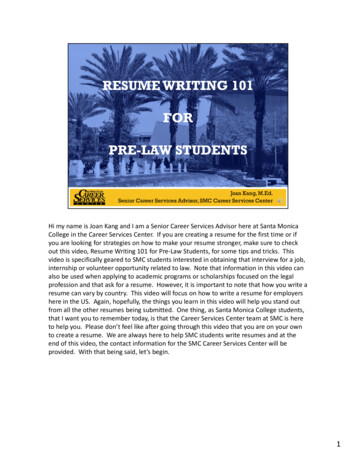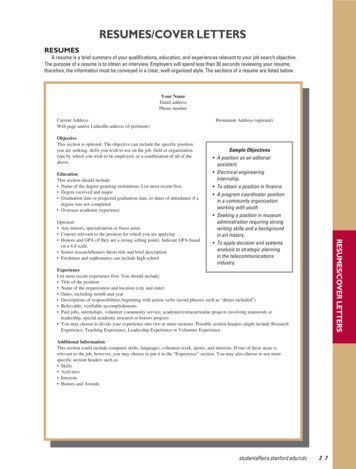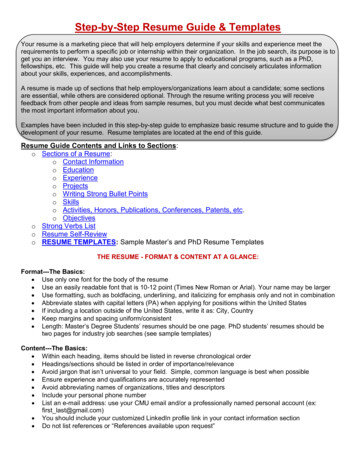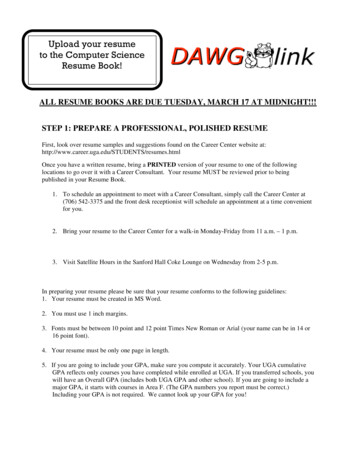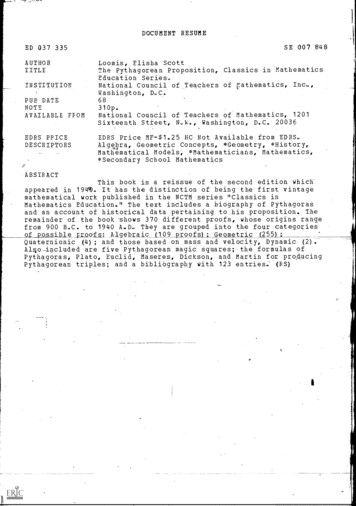
Transcription
DOCUMENT RESUMESE 007 848ED 037 335AUTHORTITLEINSTITUTIONPUB DATENOTEAVAILABLE FROMEDRS PRICEDESCRIPTORSLoomis, Flisha ScottThe Pythagorean Proposition, Classics in MathematicsEducation Series.National Council of Teachers of pthematics, Inc.,Washington, D.C.68310p.National Council of Teachers of Mathematics, 1201Sixteenth Steet, N.W., Washington, D.C. 20036EDRS Price MF- 1.25 HC-Not Available from EDRS.Algebra, Geometric Concepts, *Geometry, *History,Mathematical Models, *Mathematicians, Mathematics,*Secondary School MathematicsABSTRACTThis book is a reissue of the second edition Whichappeared in 19410. It has the distinCtion of being the first vintagemathematical work published in the NCTM series "Classics inMathematics Education." The text includes a biography of Pythagorasand an account of historical data pertaining to his proposition. Theremainder of the book *shows 370 different proofs, whose origins rangefrom 900 B.C. to 1940 A.D. They are grouped into the four categoriesof possible proofs: Algebraic (109 proofs) jGeometric (255)iQuaternionic (4) ; and those based on mass and velocity, Dynamic (2) .Al§o-included are five Pythagorean magic squares; the formulas ofPythagoras; Plato, Euclid, Maseres, Dickson, and Martin for producingPythagorean triples; and a biblibgraphy with 123 entries; (RS)t;Y.
T,-,:;.;41-it:,t -.2iMICROFICHE REPRODUCTIONtie.7.1'I, .8412 F-.--,-, ---:IP, i. :. . F,:-:,;::.'e:i ., .:Lti:';",ttriz::,.: ::3 .::I,,.f.U S. DEPARTMENT Of HEALTH, EDUCATION & WELFAREOFFICE OF EDUCATION.ir.:44fl/,:i
PROCESS WITHANDMICROFICHEPUBLISHER'S PRICES,MICROFICHEONLY.REPRODUCTIONPABP0811AN11E1N
ELISOA S. LOOMISPhotograph- taken 193501.
Pt% IiI188 kmto reproduce this copyrightedwork has beengranted to the Educational Resourct;sInformation Center(EllIci and to the organizationwith the Office 01 Education to operating under contractreproduce documental:1cluded in-the-Efi-le-systeniby Means ofmicrofiche onlybut this right is not conferredto any users of the microfiche received from theERIC Document ReproductionService. Further reproductionmission of the copyright owner. of any part requires per-HE PYTHAGOREANPROPOSITION1,4Its Demonstrations Analyzed and ClassifiedandBibliography of Sources for Data of theFoUr Kinds. of "Proofs"Ensile Scott Loomis--NATIONAL COUNCIL OF TEACHERS OF MATHEMATICS1201,Sixteenth Street, N.W., Washington, D.C. 20036j
About the AuthorElisha Scott Loomis, Ph.D., LL.B., was professor of mathematicsat Baldwin University for the period 1885-95head of themathematics department at West High School, andCleveland,Ohio,for the period 1895-1923. At the time when this second editionwas published, in 1940, he was professor emeritus ofmathematicsat Baldwin-Wallace College.About the- BookThe second edition of this book (published in Ann Arbor, Michigan, in 1940) is here reissued as the first title in *a seriesof"Classics in Mathematics Education."NCClassicsMCopyright ,ri") 1940 by Elisha S. LoomisCopyright1968 by The NationalCouncil of Teachers of Mathematics, Inc."PERM I SS IOX N TO REPRODUCE THIS COPYRIGHTEDMRAMaEEN GRANTEDt k,ounc . Teach .hTO Elk AND ORGANIZATIONS OPERATING UNDERAGREEMENTS WITH THE U. S. OFFICE OF EDUCATION.FURTHER REPRODUCTION OUTSIDE THE ER IC SYSTEMREQUIRES PERMISSION OF THE COPYRIGHT OWNER."Printed in the U.S.A. .
PREFACESome Mathematical works of considerable vintage have atimeless quality about them: Like classics in any field, theystill bring joy and guidance t.o the reader. Substantial worksof this kind, when they concern fundamental principles andproperties of school mathematics, ;are being sought out bythe Supplementary Publications Committee. Those.that areno logger readily- available will be. reissued by the NationalCouncil of Teachers of Mathematics. This book is the firstsuch classic deemed worthy of once again being made available to the mathematics education community.The initial manuscript for The Pythagorean Propositionwas prepared in 1907 and first published in 1927. With permission of the Loomis family, it is presented here exactlyasthe second---edition appe-a-redi-n 1940. Ex-ce-ptfo-rstrchnecessary changes as providing new title and copyrightpages and adding' this Preface by way of explanation, no,attempt has been, made to modernize the book in any way.To do so would surely detract from, rather than add to, itsvalue.
"In Mathematics the man who is ignorant of what Pythagoras said in Croton in.500 B.C. about the squire on the longestside of a rightangled triangle, or who forgets what someone in Czechoslovakiaprovedlast week about intqualities, is likely tobe lost.The whole terrific mass of wellestablished Mathematics, from the ancientBabylonians to the modern Japanese, is asgood today as it ever was."1.4e11,1931
FOREWORDAccording to Hume, (England's thinker whointerrupted Kant's "dogmatic slumbers"), argumentsmay be divided into:(a) demonstrations; (b) proofs;(c) probabilities.By a demonstration, (demonstro, to cause to'see), we mean a reasoning consisting of one or morecatagorical propositions "by'which some proposition,brought into question is shbwn to be contained insome other prOposition'assumedlyhose truth and certainty being evident and acknowledged, the proposition in question must also be admitted certain. Theresult is science, knowledge, certainty."' The knowledge which demonstration gives is fixed and unalterable.It denotes necessary consequence, and issynonymous with proof from first principles.By proof, (probo, to make credible, to demonstrate), we mean 'such an argument from experienceas leaves no room for doubt or opposition'; that is,evidence confirmatory of &proposition, and'adequateto establish it.The object of this work is to present to thefuture investigator, simply and concisely, what isknown relative to the so-called Pythagorean Proposition, (known as the 47th proposition of Euclid and asthe "Carpenter's Theorem"), and to set forth certainestablished facts concerning the algebraic and geometric proofs and the geometric figures pertainingthereto.It establishes that:First, that there are but four kinds of demonstrations for the Pythagorean propobition, viz.:I. Those based upon Linear Relations. (implying the Time Concept)Aithe Algebraic Proofs.vii
THE PYTHAGOREAN PROPOSITIONII. Those-based-upon Comparison of Areas(implying the Space Concept)--the Geometric Proofs.III. Those based upon Vector Operation (implying the Direction Concept)--the QuaternionicProofs.IV. Those based upon Mass and Velocity (implying the Force Concept)--the Dynamic Proofs.Second, that the number of Algebraic proofsis limitless.Third, that there are only ten types of geometric figures from which a Geometric Proof can bededuced.This third fact is not mentioned nor impliedby any work consulted by the author of this treatise,but which, once established, becomes the basis forthe classification of all possible geometric proofs.Fourth, that the number of geometric proofsis limitless.Fifth, that no trigonometric proof is possi-By consulting the Table of Contents any investigator can determine iii-what field his proof,falls, and then, by reverence to the text, he canfind out wherein it differs from what has alreadybeen established.With the hope that this simple exposition ofthis historically renowned and mathematically fundamental proposition, without which the science of Trigonometry and all that it implies would be impossible,may interest many minds and prove helpful and sugges-tive to the student, the teacher and the future original investigator; to each and to all who are seekingmore light, the author, sends it forth.ry,
CONTENTSFigures PageForewordPortraitsAcknowledgmentsAbbreviations and ContractionsThe Pythagorean PropositionBrief Biographical InformationSupplementary Historical DataAn Arithmetico-Algebraic Point of ViewRules for Finding,Integral Values for a, b and hviixixiiixv3711171922.Methods of Proof - -k Method6I. Algebraic Proof:. Through Linear Relations.23.A. Similar Right Triangles--several thousand proofspossible1- 35B. The Mean Proportional Principle36- 53C. Through the Use of the Circle95- 992351606061687480838688100-1039154- 85(I) Through the Use of One Circle(1) 'The Method of Chords(2) The Method by Secants54- 85(3) The Method by Tangents(II) ThroUgh the Use of Two Circles77- 8586- 8754- 6869- 76D. Through the Ratio of AreasE.,ThroAgh the Theory of LimitsF. Algebraic-Geometric Complex88- 9293- 94G. Algebraic-Geometric Proofs Through SimilarPolygons, Not Squares-1,II. Geometric Proofs--10 Types-Type.i.C-Type.All three sq's const'd exteriorThe h-square const'd interiorThe b-square const'd interior.D-Type.The a-square const'd interior.E-Type.The h- and b-sq's const'd interiorThe h- and a-sq's const'd interior217-224The a- and b-sq's const'd interiorAll three sq's const'd 171172 4176185
xTHE PYTHAGOREAN PROPOSITIONFiguresPageI-Type.One or more squares translated, giving 7 classes covering 19 different cases(1) Four cases256-260(2) Your cases261-276(3) Four cases277-288(4) Two cases289-290(5) Two cases291-293(6) Two cases294-305(7) One caseJ-Type. One or more of the squares notgraphically represented--Two sub-types(A) Proof derived through a square, giv-ing 7 classes covering 45 distinctcases(1) Twelve cases, but 2 givsg .(2) Twelve cases, but 1 given .(3) Twelve .cases, none given(4) Three cases,(5) Three cases, none given(6) Three cases, all 3 0312-31321621821922.10.314-328222329-346230230(B) Proof based upon a triangle throughcalculations and comparisons ofequivalent areasWhy No Trigonometric, Analytic GeometryNor Calculus Proof PossibleIII. Quaternionic ProofsIV. Dynamic ProofsA Pythagorean 'CuriosityPythagorean Magic 281
PORTRAITS1. Loomis, Elisha SFrontispiece2. Copernicusfacing page88IIn244nn118nn1886. Gaussnn167. Leibniznn588. Lobachevskynn2109. Napiernn14410. Newtonnn16811. Pythagorasnn12. Sylvesternn3. Descartes4. Euclid5. Galileo,xi8266
ACKNOWLEDGMENTSEvery man builds upon his predecessors.My predecessors made this work possible, andmay those who make further investigations relativeto this-renowned proposition do better than theirpredecessors have done.The author herewith expresses his obligations:field,hereined himto theownersproofsTo the many who have preceded him in thisand whose text and proof he has acknowledgedon the page Where such proof is found;To those whol.upon request,, courteously grantpermission to make use, of such proof, or refersame;To the following Journals and Magazines whose.so kindly extended to him permission to usefound therein, viz:.The American Mathematidal Monthly;Heath's Mathematical Monographs;The Journal of Education;The Mathematical Magazine;The Schodl Visitor;The Scientific American Supplement;Science and Mathematics; andScience.,To. Theodore H. Johnston, Ph.D., formerlyPrincipal of the West High School, Cleveland, Ohio,for his valuable stylistic suggestions after readingthe original manuscript in 1907.To Professor Oscar Lee DustheiMer; Profe,ssorof Mathematics and Astronomy, Baldwin-Wallace\College,Berea, -Ohio, for his professional assistance and advice; and to David P. Simpson, 33 , former Principalof West High School; Cleveland, Ohio, for his brotherly encouragement, and helpful suggestions, 1926.xiii
xivTHE PYTHAGOREAN PROPOSITIONTo Dr. Jehuthiel Ginsburg, publisher ofScripta Mathematica, New York City, for the right toreproduce, the photo plates of ten of his "Portraitsof Emineht Mathematicians."To Elatus G. Loomis for his assistance indrawirig*the 366 figures which appear-in this SecondEdition.And to "The Masters;and Wardens Associationof The 22nd Masonic District of the Most WorshipfulGrand Lodge of Free and Accepted Masons of Ohio,"owner of the Copyright granted to it in 1927, for itsgenerous permission" tO'Publish this Second Editionof The Pythagorean Proposition, the author agreeingthat a complimentary copy of it shall be sent to-theknown Mathematical Libraries of the World, for private research work, and also to such Masonic Bodiesas it shall select.(April 27, 1940)
ABBREVIATIONS'AND CONTRACTIONSAm: Math. Mo. The American Mathematical Monthly,100 proofs, 1894.a-square square upon the shorter leg.b-square longer leg."Colbrun Arthur R. Colbrun, LL.M., Dist. of ColumbiaBar.'const. construct.const'd constructed.cos cosine.Dem. demonstrated, or demonstration.Edw. Geom. Edward's Elemehts of Geometry, 1895.eq. equation.eq's equations.Fig. or fig. figure.Fourrey E. Fourrey16 Curiosities Geometriques.Heath Heath's Mathematical Monographs, 1900,Parts I and II--26 proofs.h-square square upon the hypotenuse.Jour. Ed'n Journal of Education.Legendre". Davies Legendre, Geometry, 1858.Math:. mathematicsMath. Mo. Mathematical Monthly, 1858-9.Mo. Monthly.No. or no. number.Olney's Geom. -01ney's Elements of Geometry, University Edition.outw'ly outwardly.par. parallel.paral. parallelogram.perp. perpendicular.p. page.pt. point.quad. .quathiilateral.resp'y respectively.xv
xviTHE PYTHAGOREAN PROPOSITIONRichardson John M. Richardson--28 proofs.rt. right.rt. tri. right triangle.rect. rectangle.Sci. Am. Supt. Scientific American Supplement,1910, Vol. 70.sec secant.sin sine.sq. square.sq's squares.tang tangent. therefore.tri. triangle.tri's - triangles.trap. trapezoid.V. or v. volume.Versluys Zes en Negentic (96) Beweijzen Voor HetTheorema Van Pythagoras, by J. Versluys, 1914.Wipper Jury Wipper's "46 Beweise der Pythagor-,aischen Lehrbatzes," 1880.11E2, or any like symbol . the square of, or upon, theline HE, or like symbol.ACSee proof 17.ACIAF, or -like symbol AC AF, or
OptAciv rca oecpGOD GEOMETRIZESCONTINUALLY-PLATO
THE PYTHAGOREAN PROPOSITIONThis celebrated proposition is one of themost important theorems in the whole realm of geometry and is known in history as the 47th proposition,that being its number in the first book of Euclid'sElements.It is also (erroneously) sometimes called thePons Asinorum. Although the practical applicationof this theorem was known lbhg before the time, ofPythagoras he, doubtless, generalized it from an Egyp42tian rule of thumb (3252) and first demonstrated it about 540 B.C., from which fact it is generally known as the Pythagorean Proposition.Thisfamous theorem has always been a favorite with geometricians.(The statement that Pythagoras was the inventor of the 47th proposition of Euclid haS beee denied by many students of the subject.)Many purely geometric demonstrations of thisfamous theorem are accessible to the teacher, as wellas an unlimited number of proofs ,based Upon the algebraic method of geotetric investigation.Alsoguaternions and dynamics furnish a few proofS.-No doubt many other proofSthan these nowknown will be resolved by future investigators, forthe possibilities of the algebraic and geometric relationsimplied-in-'ihe theorem are limitless.This theorem -with its many prO0fS is a striking illustration of the fact that there is more thanone way of establishing the-same truth.But before proceeding to the methods., of demonstration, the following historical account translated from a monograph by Jury Wipper, published-.in1880, and entitled "46 Beweise des pythagoraischen.Lehrsatzes," may prove both interesting and profita)ble.3
ittiTHE PYTHAGOR4AN PROPOSITIONWipper acknowledges his indebtedness toP. Graap who translated it out of the Russian. It isas follows:"One of the weightiest propositions ingeometry if not the weightiest with reference to itsdeductions and applications is doubtless the socalled Pythagorean proposition."The Greek text is as follows:'Ev Toic Opeoywviot s TO emo Tric ;Eliv 604vywviav 6noTetvoihri nXtupEic TeTpdywvov !oov kaTi Toildm!) T6iv VII, 600 ywviav nEplExounlv nXeup@vTETparivotc.The Latin reads:In rectangulis triangulisquadratum, quod a latere rectum angulum subtendentedescribitur, aequale est eis, quae a lateribus rectumangulum continentibus describuntur.German:In den rechtwiikeligen Dreiecken istdas -Quadrat, welcher . von der dem rechten Winkelgegenuber liegenden Seite beschrieben Wird, den Quadraten, welche von den ihn umschliessenden Seitenbeschrieben werden, gleic4.According to the 'testimony of Proklos thedemonstration of this proposition is due to Euclidwho adopted it in his elements (I, 47). The methodof the Pythagorean demonstration remains unknown tous.It is undecided whether Pythagoras himself discovered this characteristic of the right triangle, orlearned it from Egyptian priests, or took it from,'Babylon: regarding this opinions vary.According to that one most widely disseminated Pythagoras learned from the Egyptian priests thecharacteristics of a triangle in which one leg 3(designating Osiris), the second 4 (designatingIsis), and the hypotenuse 5 (designating Horus):for which reason the triangle itself is also namedthe Egyptian or Pythagorean.**(Note.The Grand Lodge Bulletin, A.F. and A.M., of Iowa, Vol.30, No. 2, Feb. 1929, p. 42, has: In an old Egyptian manuscript, recently discovered at Kahan, and supposed to belong-
THE PYTHAGOREAN PROPOSITION5The characteristics of such a triangle, however, were known not to the Egyptian priests alone,the Chinese scholars also knew them."In Chinesehistory," says Mr. Skatschkow, "great honors areawarded to the brother of the ruler Uwan, Tschou-Gun,who lived 1100 B.C.: he knew the characteristics ofthe right triangle,(perfected) made a map of thestars, discovered the compass and determined thelength of the meridian and the equator.Another scholar (Cantor) says:this emperorwrote or shared in the composition of a mathematicaltreatise in which were discovered the fundamentalfeatures, ground lines, base lines, of mathematics,in the form of a dialogue between Tschou-Gun andSchau-Gao. The title of the book is:Tschaou pi;i.e., the high of Tschao. Here too are the sides ofa triangle already named legs as in the Greek, Latin,German and Russian languages.Here are some paragraphs of the 1st chapterof the work. Tschou-Gun once said to Schau-Gao: "Ilearned,- sir, that you know numbers and their applications, for which reason I would like to ask how oldFo-chi determined the degrees of the celestial sphere.There are no steps on which one can climb up to thesky, the chain and the bulk of the earth are also inapplicable; I would like for this reason, to know howhe determined the numbers."Schau-Gao replied: "The art of counting goesback to the circle and square."If one divides a right triangle into itsparts the line which unites the ends of the sides(Footnote continued)to the time of the Twelfth Dynasty, we62(1,x)2; 82find the following equations: 12 (4)2 102; 22 (12)2 (2P 2-; 162 122 202; all of which areforme of the 3-4-5 triangle.We also find that this triangle was to them the symbol of universal nature. The base 4represented Osiris; the perpendicular 3, Isis; and the hypotenuse represented Horus, their eon, being the product, of thetwo principles, male and female.)
6,THE PYTHAGOREAN PROPOSITIONwhen the base 3, the altitude 4 is"That is indeed exTschou-Gun cried out:cellent."It is to be observed that the relations between China and-Babylon more than probably led to theassumption that this characteristic was already knownto the,Chaldeans. As to. the geometrical demonstration it- comes doubtless from Pythagoras himself. Inbusying with the addition of the series he could verynaturally g6 from the triangle with sides 3, 4 and 5,as a single instance to the general characteristicsof the right triangle.After he observed that addition of the seriesof odd number (1 3 4, 1 3 5 9, etc.) gavea series of squares, Pythagoras formulated the rulefo'r finding, logically, the sides of a right triangle:Take an odd number (say 7) which forms the shorterside, square it (72 49), subtract one EIL9 - 1 48),halve the remainder (48 - 2 24); this half is thelonger side, and this increased by one (24 1 25),is the hypotenuse.The ancients recognized already the signifi-,cance of the Pythagorean proposition for which factmay serve among others as proof the account of Diog9.nes Laertius and Plutarch concerning Pythagoras. Thelatter is said to have offered (sacrificed) the Godsan ox in gratitude after he learned the notable charThis story isacteristics of the right triangle.without doubt a fiction, as sacrifice of animals,i.e., blood-shedding, antagonizes the Pythagoreanteaching.During the middle ages this proposition whichwas also named inventum fiecatombe dtgnum (in -as -muchas it was even believed that a sacrifice of a hecatomb--100 oxen--was offered) won the honor-designation Naftster matieseos, and the knowledge thereofwas some decades ago still the prodf of a solid mathematical training (or education). In examinations toobtain the master's degree thi's proposition was oftengiven; there was indeed a time, as is maintained,
THE-TYTEN.GOREANTROPUSITION7when from every one who Submitted himself to the testas master of mathematics a new (Original) demonstration was required.This latter circumstance, or rather the greatsignificance of the proposition under considerationwas the reagon why numerous demonstrations of it werethought out.The collection of demonstrations which webring in what follows,* must, in our opinion, notmerely satisfy the simple thirst for knowledge, butalso as important aids in the teaching of geometry.The variety of demonstrations, even when some of themare finical, must demand in the learners the development of rigidly logical thinking, must show them howmany sidedly an object can be considered, and spurthem on to test their abilities in the discovery oflike demonstrationi for gthe one or the other proposition."Brief Biographical InformationConcerning Pythagoras"The birthplace of Pythagoras was the islandof Samos; there the father of Pythagoras, Mnessarch,obtained citizenship for services which he had rendered the inhabitants of SamoS during a time of famine.Accompanied by his wife Pithay, Mnessarch!requently traveled in business interests; during theyear 569 A.C. he came to Tyre; here Pythagoras wasborn. At eighteen Pythagoras, secretly, by night,went from (left) Samos; which was in the power of thetyrant Polycrates, to the island Lesbos to his unclewho welcomed him very hospitably. There for two years,he received instruction from Ferekid who with Anaksithander and Thales had the reputation of a philosopher.*Note.There were'but 46 different demonstrations in the monograph by Juryliipper, which 46 are among the clagsified collection found in this work.
jji8THE PYTHAGOREAN .PROPOSITIONAfter Pythagoras had made the .reaigio:u.s ideasof his teacher his own, he went to Anaksimander andThales in Miletus (549 A.G.). The latter was thenalready 90 years old. With these men Pythagoras studied chiefly cosmography, i.e., Physics and Mathematics.04*Of Thales it is known that he borrowed thesolar year from Egypt; he knew how to calculate sunand moon eclipses, and determine the elevation of apyramid from its shadow; to him also are attributedthe discovery of geometrical projections of great import; e.g., the characteristic of the angle which isinscribed and rests with its sides on the diameter,as well as the characteristics of the angle at thebase of an (equilateral) isosceles triangle.Of Anaksimander it is known that he knew theuse of the dial in the determination of the sun's elevation; he was the first who taught geography andIt must be observeddrew geographical maps on copper.too, that Anaksimander was the first prose writer, asdown to his day all learned works were written in,verse, a procedure which continued longest among theEast Indians.Thales directed the eager youth to Egypt asthe land where he could satisfy his thirst for knowlThe Phoenician priest college in Sidon must inedge.some degree 'serve as preparation tor this journey.Pythagoras Spent an entire year there and arrived inEgypt 547,"Although Polikrates who had forgiven Pythagoras' nocturnal flight addresses to Amasis a letterin which he commended the young scholar, it costPythagoras as a foreigner, as one unclean, the mostincredible toil to gain admission to the priest castewhich only unwillingly initiated even their own people into their mysteries or knowledge.The priests in the temple Heliopolis to whomthe king in person brought Pythagoras declared it impossible to'receive' him into.their midst, and directed him to the oldest priest college at Memphis, this
:.:,v,"k- 1.1PYTHAGORASFrom a Fresco by Raphael
THE PITHAGOREANY ROP.OSITION9---commended him.to Thebes. Here Somewhatsevere conditions were laid upon Pythagoras forhis receptioninto the priest caste; but nothingcould deter him.Pythagoras performed all the rites,and all tests,and his study began under theguidance of the chiefDriest Sonchis.During his 21 years stay in EgyptPythagorassucceeded not only'in fathomingand absorbing all theEgyptian but also became sharer in thehighest honorsof the priest caste.In 52.7 Athasis died; in thefollowing (526)year in the reign of Psammenit,son.of Amasis, thePersian king Kambis invadedEgypt arid loosed all hisfury against the priest caste.Nearly all members thereof fell intocaptivity, among them Pythagoras, to whomas abode Babylonwas assigned. Here in thecenter of the world commerce where Bactrians, Indians, Chinese\i,Jews and,other folk came tovther,Pythagorad had during 12years stay opportunity to acquirethose learnings inwhich the Chaldeanswere so- rich.A singular accident securedPythagoras liberty in-consequence of which hereturned to his nativeland in his 56th year. After a briefstay on theisland Delos where he foundhis teacher Ferekid stillalive, he spent a half year ina visit to Greece forthe purpose of making himselffamiliar,vith the re-ligious, scientific and socialcondition thereof.The opening of the teachingactivity of Pythagoras, on the island of Samos,wasextraordinarilysad; in order not to remainwholly' without pupils hewas forced even to pay his sole pupil,who was alsonamed Pythagoras, a son of Eatokles.This led himto abandon his thankless land,andseek anew home inthe highly cultivated citiesof Magna GraeciaIn 510 Pythagoras came to Kroton.As isknown it was a turbulent year.Tarquin was forced toflee from Rome, Hippias fromAthens; in the neighborhood of Kroton, inSibaris,,insurrection broke out.The first appearance (4Pythagoras before the 1people of Kroton began Ir'ithanoration to the youth
10THE PYTHAGOREAN PROPOSITIONwherein he rigorously but at the same time so convincingly set forth the duties of young men that theelders of the city entreated him not to leave themwithout guidance (counsel).In his second orationhe called attention to law abiding and purity of morals as the butresses of the family.In the two following orations he turned to the matrons and children.The result of the last oration in which hespecially condemned luxury was that thousands of'costly garments were brought to the temple of Hera,beoause no matron could make up her mind to appearin them on the street.Pythagoras spoke captivatingly, and it is forthis reason not to be wondered at that his orationsbrought about a change in the morals of KrOton's inhabitants; crowds of listeners streamed, to him.Besides the youth who listened all day long to.histeaching some 600 -of-the worthiest men of the city,.matrons and maidens, came together at his eveningentertainments; among them was the young, gifted andbeautiful Theana, who thought it happiness to becomethe wife of the 60 year old teacher.The listeners divided accordingly.into disciples, who formed a school in the narrower sense ofthe word, and into auditors, a schOol in the broadersense.- The former, the so-called mathematicians weregiven the rigorous teaching of Pythagoras as a scientific whole in logical succession from the prime concepts of mathematics up to the highest abstraction of-philosophy; at the same time they learned toeverything fragmentary in knowledge as more harmfulthan ignorance even.From the mathematicians must be distinguishedthe auditors (university extensioners) out of whomsubsequently were formed the Pythagoreans.Thesetook part in the evening lectures only in which noth:ing rigorously scientific was taught.The chiefthemes of-these lectures were: ,ethics, immortalityOf the soul, and transmigration--metempsy,lhology.About the year 490 when the Pythagoreanschool reached its highest splendor,-brilliancy---a-
---THE'PYTHAGOREAN PROPOSITION11certain Hypasos who had been expelled from the schoolas unworthy put himself at the head of the democraticparty in Kroton and appeared as accuser of his formerColleagues.The school was broken up, the propertyof Pythagoras was confiscated and he himself exiled.The subsequent,16 years Pythagoras lived inTarentum, but even here the democratic party gainedthe upper hand in 474 and Pythagoras a 95-year oldman, must flee again to Metapontus where he draggedout his poverty-stricken existence 4 years'mOre. Finally democracy triumphed there also; the house inwhich was the school was burned, many disciples dieda death of torture and Pythagoras himself with difficulty having escaped the flames died boon after inhis 99th year."*fc,Supplementary Historical DataTo.the followingof the RusSian, relativegoras, these interesting"Fifteen hundred(Graap's) translation, outto the great master Pythastatements are due.years before the time ofPythagoras, (5497.470 B.C. ),** the Egyptians constructed right angles by so placing three pegs that a ropemeasured off into 3, 4 and 5 units would just reacharound them, and for this purpose professional 'ropefastene
AGREEMENTS WITH THE U. S. OFFICE OF EDUCATION. Printed in the U.S.A. FURTHER REPRODUCTION OUTSIDE THE ER IC SYSTEM REQUIRES PERMISSION OF THE COPYRIGHT OWNER." . . Four cases 277-288 201 (4) Two cases 289-290 206 (5) Two cases 291-293 208 (6) Two cases 294-305 209 (7) One case 306 215 J-Type. One or more of the squares not






